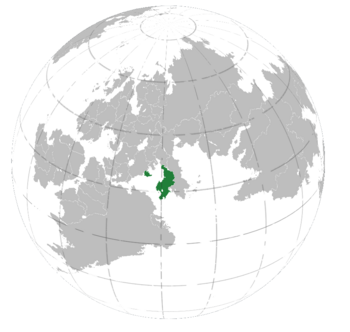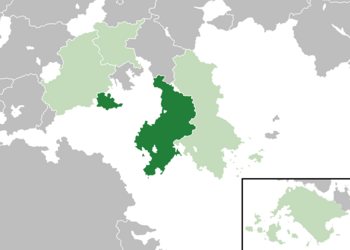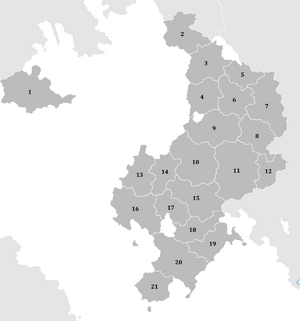Qal'eh: Difference between revisions
No edit summary |
No edit summary |
||
| Line 47: | Line 47: | ||
|established_date6 = November 17, 1989 | |established_date6 = November 17, 1989 | ||
|area = <!--Major area size (in [[Template:convert]] either km2 or sqmi first)--> | |area = <!--Major area size (in [[Template:convert]] either km2 or sqmi first)--> | ||
|area_km2 = | |area_km2 = | ||
|population_census = 52,981,727 | |population_census = 52,981,727 | ||
|population_census_year = 2013 | |population_census_year = 2013 | ||
| Line 74: | Line 74: | ||
}} | }} | ||
The '''Sublime State of Qal'eh''', commonly known as simply '''Qal'eh''' ({{wp|Farsi|Qalehi}}: قله ''Qāleh'' [[https://en.wikipedia.org/wiki/Help:IPA/Persian kæleh]] is a country in Western [[Catai]]. With almost 53 million inhabitants, Qal'eh is | The '''Sublime State of Qal'eh''', commonly known as simply '''Qal'eh''' ({{wp|Farsi|Qalehi}}: قله ''Qāleh'' [[https://en.wikipedia.org/wiki/Help:IPA/Persian kæleh]] is a country in Western [[Catai]]. With almost 53 million inhabitants, Qal'eh is the [[List of Aeian countries by GDP|20th most populous country in Aeia]]. Comprising a land area of Xkm², Qal'eh is one of the largest nations in its region. It borders [[Kodesh]] to the east and [[Uwhistan]] to the north. | ||
Qal'eh was first conquered by the expansive Artakhshathran Empire in 273, who destroyed many ancient relics of the tribes of Qal'eh following their conquest, while simultaneously assimilating the culture of the tribesman into a more widely-accepted culture throughout the Empire. Many modern Qalehi traditions can have their roots traced back to the Artakhshathran Empire and the culture of the nation is heavily influenced by the conquest. The region broke away from the Artakhshathran Empire as many small successor states after a mutiny in the 10th century CE caused the army and many minorities within the empire to revolt, eventually leading to its demise. The largest successor state, Assadia, led by Muridin Emir Imrah I, reconquered the shattered realm between 1024 and 1026 in a series of conflicts now known as [[Imrah's Conquests]]. Modern-day Qal'eh unified around 200 years after the Assadian Caliphate ceased to exist, when the three powers in the region agreed to unite into a singular nation under [[List of Shahs of Qal'eh|Shahanshah]] [[Amin Rouhani]], the first of to bear the title in the region for almost a thousand years. Qal'eh would undergo a civil war between monarchists loyal to the Shah and Qalehi republicans, which would end in 1902 and lead to the ratification of the 1902 Constitution, which still holds supreme law in the region. It is a controversial topic in Qal'eh, and its lawfulness is debated due to its age. | Qal'eh was first conquered by the expansive Artakhshathran Empire in 273, who destroyed many ancient relics of the tribes of Qal'eh following their conquest, while simultaneously assimilating the culture of the tribesman into a more widely-accepted culture throughout the Empire. Many modern Qalehi traditions can have their roots traced back to the Artakhshathran Empire and the culture of the nation is heavily influenced by the conquest. The region broke away from the Artakhshathran Empire as many small successor states after a mutiny in the 10th century CE caused the army and many minorities within the empire to revolt, eventually leading to its demise. The largest successor state, Assadia, led by Muridin Emir Imrah I, reconquered the shattered realm between 1024 and 1026 in a series of conflicts now known as [[Imrah's Conquests]]. Modern-day Qal'eh unified around 200 years after the Assadian Caliphate ceased to exist, when the three powers in the region agreed to unite into a singular nation under [[List of Shahs of Qal'eh|Shahanshah]] [[Amin Rouhani]], the first of to bear the title in the region for almost a thousand years. Qal'eh would undergo a civil war between monarchists loyal to the Shah and Qalehi republicans, which would end in 1902 and lead to the ratification of the 1902 Constitution, which still holds supreme law in the region. It is a controversial topic in Qal'eh, and its lawfulness is debated due to its age. | ||
Revision as of 16:02, 23 April 2019
The Sublime State of Qal'eh دولتی الییه قلعه Dolate Eliyye Qal'eh | |
|---|---|
| Motto: بهتر است که امروز به عنوان یک مرد آزاد به عنوان یک برده فرد بمیریم (Persian) Bhetr Aset Keh Amerwez bh 'Enewan ak Merd Azad bh 'Enewan ak Berdh Ferd Bemaram ("Better to die today a free man than tomorrow a slave.") | |
| Anthem: سرود قلیلی ("Qalehi Hymn") | |
 | |
 Location of Qal'eh (green) in Western Catai. | |
| Capital | Dahrzor |
| Largest city | Kyderabad |
| Official languages | Qalehi |
| Ethnic groups | 74.2% Qalehis 18.8% Arians 2.2% Uruqs 1.9% Omurans 2.9% Other |
| Religion | State religion: Irsad (Malufi) Recognised minorities: Irsad (Rafada, Muadhi) |
| Demonym(s) | Qalehi |
| Government | Absolute monarchy |
| Ahmad Rouhani | |
| Assembly of Qalehis | |
| Irsadic Assembly of the Peoples of Qal'eh | |
| Establishment | |
• Qafavid Empire | c. 273 |
• Assadian Empire | c. 1017 |
• Qalehi Civil War | 1796 - 1812 |
• Monarchy re-established | April 5, 1812 |
• Current constitution | January 21, 1901 |
• 1989 Decree | November 17, 1989 |
| Population | |
• 2013 census | 52,981,727 |
• Density | 39.34/km2 (101.9/sq mi) |
| GDP (nominal) | 2017 estimate |
• Total | $659,728,464,604 |
• Per capita | $12,452 |
| Gini (2015) | high |
| HDI (2015) | very high |
| Currency | Qalehi Zaar (QLZ) |
| Date format | dd-mm-yyyy (official) |
| Driving side | left |
| Calling code | +872 |
| ISO 3166 code | QL |
| Internet TLD | .ql |
The Sublime State of Qal'eh, commonly known as simply Qal'eh (Qalehi: قله Qāleh [kæleh] is a country in Western Catai. With almost 53 million inhabitants, Qal'eh is the 20th most populous country in Aeia. Comprising a land area of Xkm², Qal'eh is one of the largest nations in its region. It borders Kodesh to the east and Uwhistan to the north.
Qal'eh was first conquered by the expansive Artakhshathran Empire in 273, who destroyed many ancient relics of the tribes of Qal'eh following their conquest, while simultaneously assimilating the culture of the tribesman into a more widely-accepted culture throughout the Empire. Many modern Qalehi traditions can have their roots traced back to the Artakhshathran Empire and the culture of the nation is heavily influenced by the conquest. The region broke away from the Artakhshathran Empire as many small successor states after a mutiny in the 10th century CE caused the army and many minorities within the empire to revolt, eventually leading to its demise. The largest successor state, Assadia, led by Muridin Emir Imrah I, reconquered the shattered realm between 1024 and 1026 in a series of conflicts now known as Imrah's Conquests. Modern-day Qal'eh unified around 200 years after the Assadian Caliphate ceased to exist, when the three powers in the region agreed to unite into a singular nation under Shahanshah Amin Rouhani, the first of to bear the title in the region for almost a thousand years. Qal'eh would undergo a civil war between monarchists loyal to the Shah and Qalehi republicans, which would end in 1902 and lead to the ratification of the 1902 Constitution, which still holds supreme law in the region. It is a controversial topic in Qal'eh, and its lawfulness is debated due to its age.
The sovereign state of Qal'eh is a minor-to-middle regional power in Catai, and enjoys good relations with its neighbour, Kodesh, mainly due to the fact that both nations follow the Malufi sect of Irsad.
Qal'eh enjoys rich cultural history, with many historic relics of tribes, the Artakhshathran Empire and the Assadian Caliphate adorning the country's museums and displays. The "Qalehi Renaissance" introduced exquisite art to the region, taking on board the techniques of many influential Asuran painters and sculptors.
Etymology
Qal'eh comes from Artakhshathranian for "the Summit", supposedly named when one of its Shahs viewed the Iranic Sea from Mt. Asfak.
History
Prehistory
Tribes have walked the lands that are now Qal'eh since around 1500 BC, with evidence of several tools and fossils dating back to that era. Most notably, the Flute of Akhir, which was unearthed in 1997, has provided some insight into the culture and traditions of early Qalehi tribes.
Artakhshathran Empire
Many scattered nations occupied the land for that time period, but first major conquest came in 273 when the Artakhshathran Empire conquered Qal'eh in multiple wars between 268 and 273. Qalehi society gradually became more similar to that of the empire, and for around 400 years, the region was stable. There were some small revolts following the conquest, but none of which posed any threat to the expansive empire. It was around 1010 when major revolts across the empire erupted following a mutiny in the Artakhshathran Empire after the Shah refused to pay their wages, due to an ongoing economic crisis throughout the empire. The crisis, along with the revolts and the mutiny the empire lost control of the region and it was split into several successor states.
Assadian Caliphate
One of the successor states, Assadia, controlled most of the lucrative southern coast, and used its large income to not only fund its own army, but also to purchase multiple mercenary armies. Starting in 1024, Emir Imrah I began reconquering most of Qal'eh and uniting it under one banner once again. Due to the devastation the revolts and internal fighting with the Artakhshathran Empire, the states did not put up much resistance, and by 1026 Imrah had conquered all the way back to northern Qal'eh. With such an expansive realm, Imrah proclaimed himself Caliph of Assadia and declared the Assadian Caliphate in late 1026, the Caliphate would go on to have many successful and strong Caliphs after the death of Imrah. The Assadian Caliphate is credited with officially introducing Irsad into the Qalehi realm, with it becoming the official state religion in 1029. The Assadian Caliphate would last some 600 years until, like its predecessor, it suffered major internal revolts and eventually collapsed in 1617. Three states emerged from the revolts, but they would go on to form modern-day Qal'eh in an agreement reached in 1802.
Civil War
A civil war gripped Qal'eh between 1896 and 1901 when republican militias seized much of northern Qal'eh and proclaimed the Irsadic Republic of Arianshahr, the civil war was bloody with hefty losses on both sides, but the monarchist Qal'eh eventually emerged victorious when their forces stormed Dahrzor on April 18, 1901. The day is now celebrated as Liberation Day throughout Qal'eh. Shahanshah Muhammad Nazeri ratified the current constitution of Qal'eh on November 12, 1902.
Modern Era
The two major ethnic groups within the nation, Qalehis and Arians, have a tense relationship which has been ongoing for some 30 years (since 1989), when Shahanshah Ahmad Rouhani passed a decree giving native Qalehis priority over Arians over things such as jobs, healthcare and applying for places in the government and military. Several Arian revolts have happened across the 30 year span but so far all have been successfully put down by the Qalehi military.
Geography
Climate
The climate of Qal'eh consists of extremely hot and arid summers in the north and central regions, with little to no rain falling in the regions for most of the year. The southern coast of Qal'eh enjoys cooler summers and winters and more rainfall than its northern and central counterparts, with much of the region being covered in temperate forests, especially on the coasts of the Iranic Sea and Majulan Ocean.
Administrative Divisions
Qal'eh is divided into 21 provinces, each with its own governor personally appointed by the Shahanshah. Most of the more populous provinces, including the capital Dahrzor and largest city Kyderabad, are located in the south of the country.
Qal'eh has a high urban growth rate, with the urban population increasing from 55% to 62% between 2000 and 2017. It is predicted that by 2030, Qalehi urban population will succeed 75%. The country's largest city, Kyderabad, attracts around 150,000 migrants per year, and is an economic and cultural hub of Western Catai.
| Number on map | Province Name | Population | Number on Map | Province Name | Population |
|---|---|---|---|---|---|
| 1 | Kasahgan | 3,762,839 | 12 | Tudasht | 493,277 |
| 2 | Saremeh | 1,873,192 | 13 | Shemrabad | 2,026,883 |
| 3 | Malakeh | 1,916,283 | 14 | Mamdeh | 1,739,288 |
| 4 | Qol-e | 1,581,283 | 15 | Gonbaz | 2,028,772 |
| 5 | Ghazab | 209,812 | 16 | Dahrzor | 6,434,719 |
| 6 | Kashkamir | 972,277 | 17 | Behesht | 2,023,889 |
| 7 | Yadabad | 1,482,662 | 18 | Qujd | 2,273,992 |
| 8 | Pawari | 892,039 | 19 | Kodyan | 3,019,837 |
| 9 | Chah Maku | 2,972,377 | 20 | Kyderabad | 8,980,273 |
| 10 | Tajabad | 3,663,820 | 21 | Zarghari | 2,273,930 |
| 11 | Gur Nasab | 2,360,283 |
Government and Politics
Qal'eh is an absolute monarchy, and has been since its foundation in 1802. Between 1802 and 1902, the Shahanshah had unlimited power throughout the Qalehi realm. However, after the 1902 constitution was ratified after the Qalehi Civil War, the Shahanshah's powers were somewhat limited.
Shahanshah
The Shahanshah is responsible for supervising (and in some cases, enacting)


